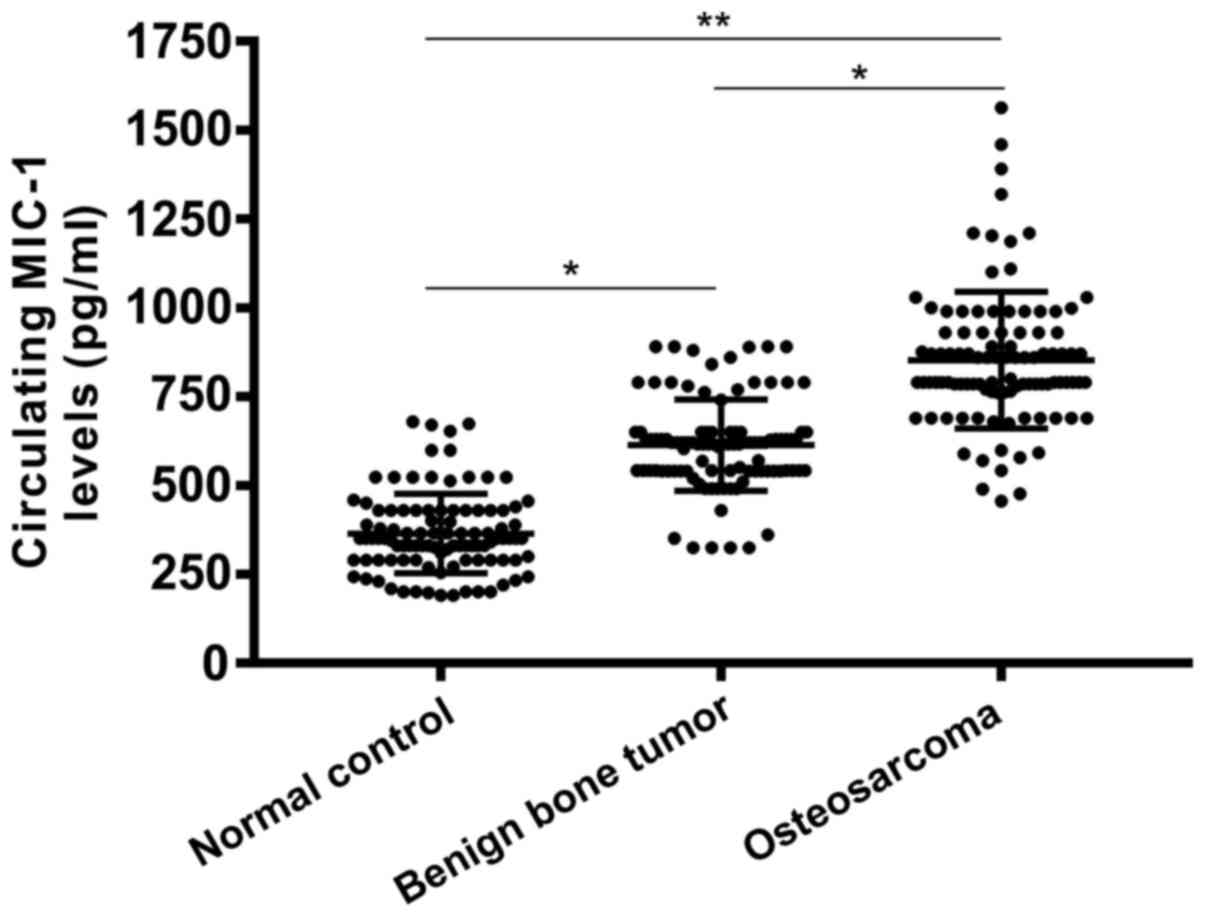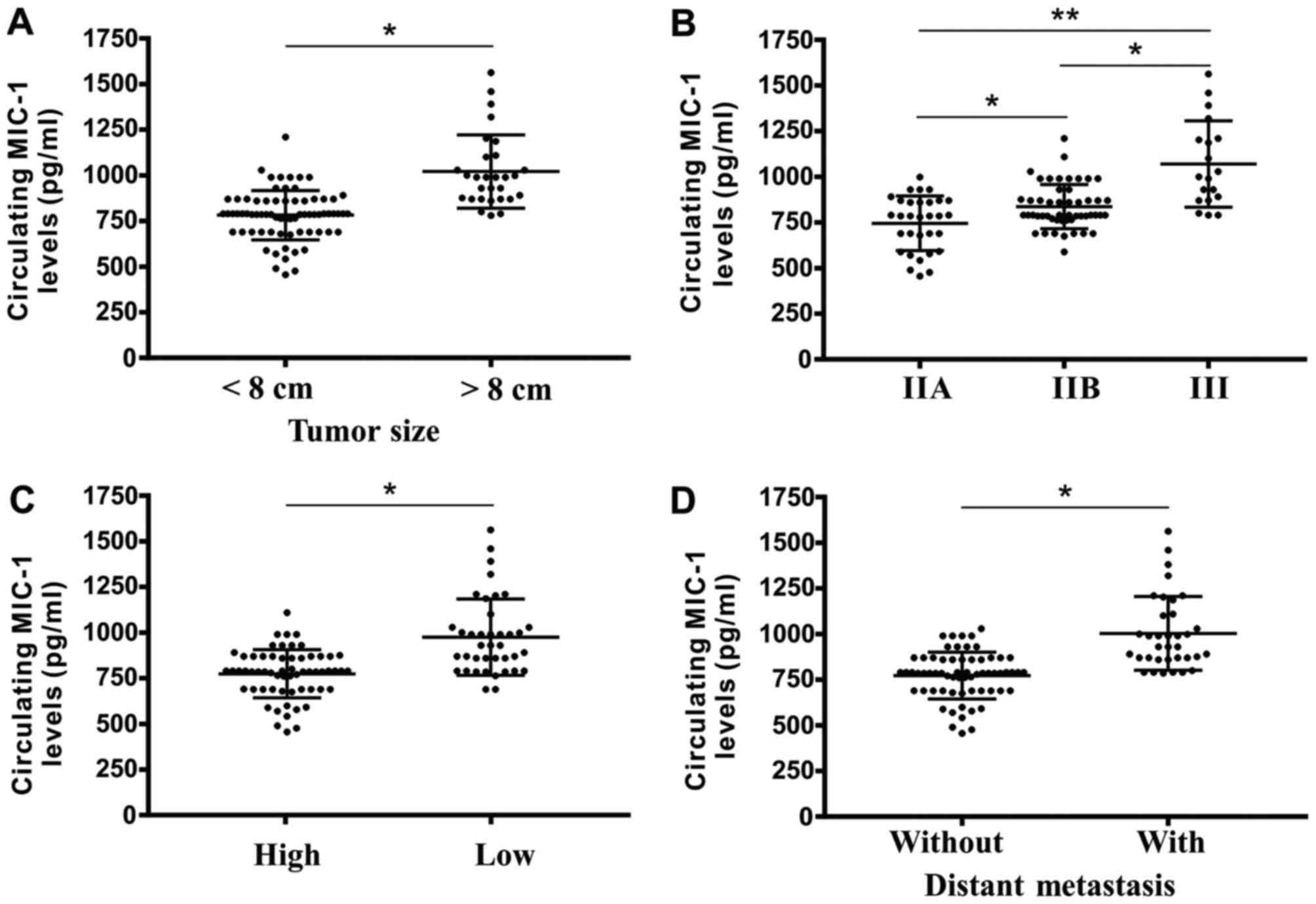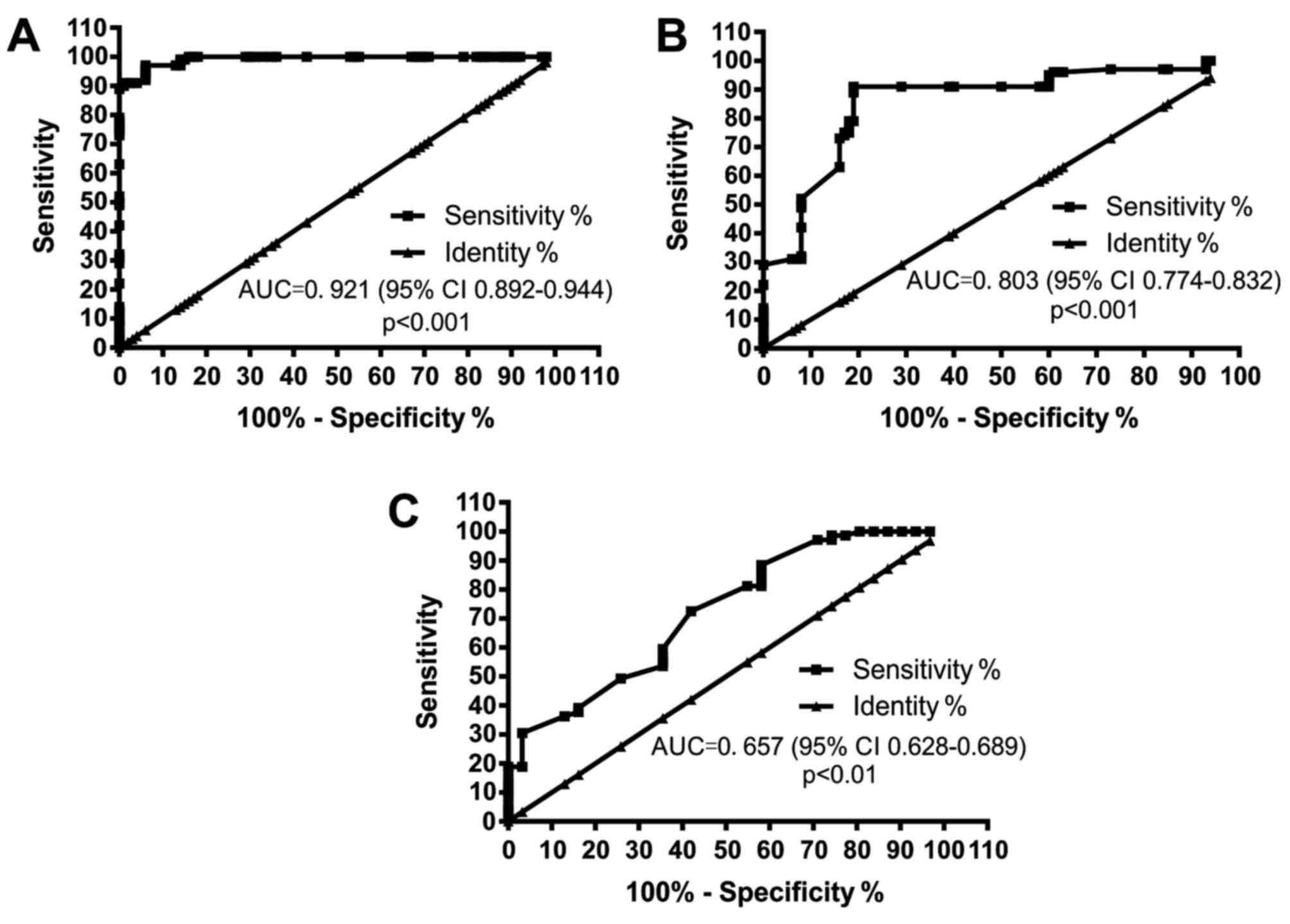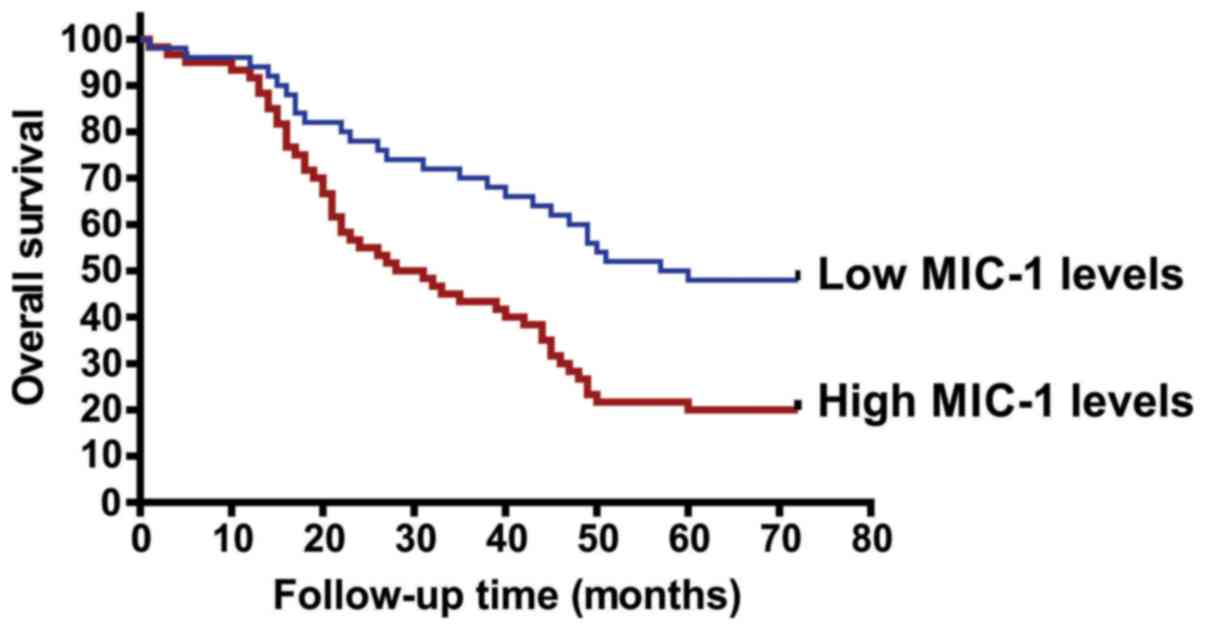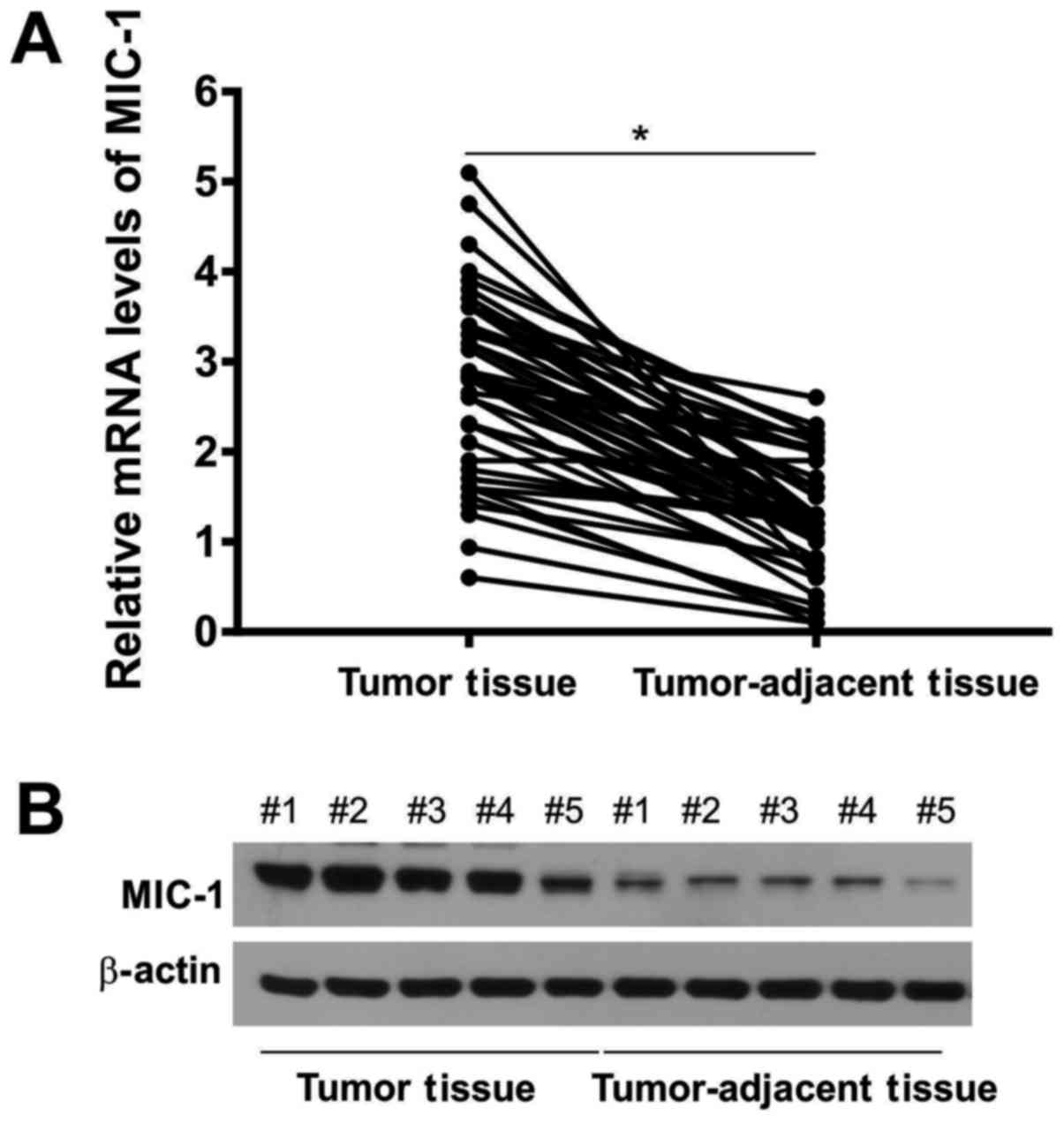Introduction
Osteosarcoma is one of the most frequently diagnosed
primary malignant bone tumors in children and teenagers, with an
incidence rate of ~4–5 individuals in every 1,000,000 individuals
(1,2). It originates from osteoid production
and nurtures immature bone tissue (3). Despite the emergence and advances in
various novel therapies, including adjuvant chemotherapy or
radiotherapy, wide local excision of relative regions is still
observed, with significant morbidity and mortality rates among
patients with osteosarcoma (4,5). The
five-year overall survival rate and five-year disease-free survival
rate of osteosarcoma have been reported to be ~50–60, and ~40% of
patients with osteosarcoma eventually succumb to mortality from
metastases in the lung tissue (6–8).
Consequently, it is imperative to develop novel diagnostic
strategies for osteosarcoma at early phases to provide more
therapeutic alternatives. Elucidating the underlying molecular
pathogenesis of osteosarcoma is important as it can assist in
targeting diagnostic and prognostic biomarkers for the most
effective therapeutic approach.
Macrophage inhibitory cytokine 1 (MIC-1) is a
secretory protein of the transforming growth factor-β (TGF-β)
family and is important in carcinogenesis-related processes,
including diffusion, metastasis, apoptosis and revascularization;
furthermore, it is involved in irregular immune activities
(9–11). MIC-1 has been considered as a
potential candidate biomarker of colorectal carcinoma (12,13).
Currently, comprehensive confirmation regarding the association
between circulating MIC-1 levels and early diagnosis of
osteosarcoma is required.
In the present study, circulating MIC-1 levels were
measured via an enzyme-linked immunosorbent assay (ELISA),
following which its correlation with tumor properties was assessed,
and the possibility of its use as a novel potential diagnostic and
prognostic maker for osteosarcoma was examined.
Materials and methods
Participants
In total, 300 patients were included in the present
study, which included 100 patients with primary osteosarcoma who
were treated in Xuzhou Children's Hospital (Xuzhou, China) between
March 2012 and May 2015. Osteosarcoma was diagnosed via clinical
and microanatomical examination, and by histological assessment of
specimens from osteosarcoma tissue. Participants did not have any
history of other tumors and did not undergo any other pre-treatment
when the initial diagnosis of osteosarcoma was confirmed. To select
patients with benign bone tumors, 100 patients with benign bone
tumors, including osteoenchondroma, ecchondrosis, bone cysts and
fibrous osteoma, were included. These bone-related benign tumors
were diagnosed via histological examination, similar to
osteosarcoma. An additional 100 healthy age- and gender-matched
subjects constituted the control group. These individuals were not
diagnosed with any orthopedic issue or tumor. The experiments and
all follow-up evaluations gained approval from the Ethics Committee
of Xuzhou Children's Hospital (no. 20130116) and all participants
provided written informed consent.
Data recording and follow-up
evaluations
For each patient, his/her demographic information,
tumor site, metastasis position, and pathological pattern were
recorded upon diagnosis. All patients with osteosarcoma were
treated with standard therapeutic pro Ethics Committee of cesses
involving new accessorial chemotherapy and wide-margin surgical
excision coupled with adjuvant chemotherapy or radiotherapy.
Chemotherapy-induced reactions were categorized into two types on
the basis of histological assessment of the osteosarcoma specimens:
Poor, when tumor cell necrosis rate was <90%; good, when tumor
cell necrosis rate was >90%. Furthermore, all patients with
osteosarcoma were monitored postoperatively. The continuous
disease-free survival period was recorded from the date of surgery
until the time of tumor recurrence or the patient succumbed to
mortality. The final follow-up record was on May 2017 and the
median value of overall survival was 40.1 months in a total range
of 10–75 months.
ELISA for circulating MIC-1
Venous blood samples from patients with osteosarcoma
were obtained upon diagnoses. The blood samples were stored in
serum separator tubes for coagulation, followed by centrifugation
at a speed of 7500 × g for 20 min at 4°C to separate serum into
other tubes at −80°C prior to ELISA for circulating MIC-1. The
level of circulating MIC-1 was assessed via a sensitive in-house
ELISA (RAB0204; Sigma-Aldrich; EMD Millipore, Billerica, MA, USA).
Remixed MIC-1 (50 µl) in different concentrations and serum were
added in a 96-well plate, with wells coated with 5 µg/ml anti-MIC-1
antibody. Thereafter, 50 µl of 0.2 µg/ml rabbit anti-MIC-1
biotinylated antibody was mixed in and incubated for 1 h at 37°C.
Streptavidin-HRP was added following cleaning the plates with
washing buffer (cat. no. RAB0204; Sigma-Aldrich; Merck KGaA,
Darmstadt, Germany), followed by incubation for 30 min at 37°C.
Eventually, the optical density of every well was measured on a
microplate reader at 450 nm. Based on the standard curve plotted
from stepwise dilution of the recombinant MIC-1, circulating MIC-1
levels from each individual were calculated. All samples were
assayed in duplicate.
Reverse transcription-quantitative
polymerase chain reaction (RT-qPCR) analysis
Resected osteosarcoma tissue samples and non-cancer
bone tissues were obtained and incubated at −80°C. RNA was isolated
from the frozen tissues using TRIzol (Invitrogen; Thermo Fisher
Scientific, USA), in accordance with the manufacturer's protocol.
Total RNA (1 µg of every sample) was used for cDNA synthesis, using
a reverse transcription kit (Takara Bio, Inc., Otsu, Japan).
Subsequently, RT-qPCR analysis was performed for synthesized cDNA
under the following cycling conditions: 2 min pre-treatment at
95°C, followed by 60°C for 15 sec, 72°C and 95°C each for 30 sec,
in 35 cycles, and extension at 72°C for 5 min. The samples were
then maintained at 4°C. RT-qPCR reactions were performed using an
ABI Prism 7000 sequence detection system (Applied Biosystems;
Thermo Fisher Scientific, Inc., Waltham, MA, USA) with the GoTaq
qPCR Master Mix (Promega Corporation, Madison, WI, USA). The
following primers were used: MIC-1, forward
5′-CGGAATTCATGGCGCGCAACG-3′ and reverse
5′-CCCTCGAGTATGCAGTGGCAGT-3′; β-actin, forward
5′-AGGCACCAGGGCGTGAT-3′ and reverse 5′-GCCCACATAGGAATCCTTCTGAC-3′.
Relative mRNA levels of all genes were normalized against the
levels of β-actin using the ΔΔCq method (14). The experiments were repeated three
times.
Western blot analysis
The tumor tissues and their adjacent tissues were
homogenized in ice and lysed in RIPA buffer with protease
inhibitors (Sigma; EMD Millipore) and phenylmethylsulfonyl fluoride
(Sigma; EMD Millipore). The dissolved solid was sonicated and
centrifuged at a speed of 7,500 × g at 4°C for 5 min. Supernatant
liquor was obtained following precipitation. Proteins were
extracted their concentrations were determined using a BCA Protein
kit (Thermo Fisher Scientific, Inc.). Protein (50 µg) was then
separated via sodium dodecyl sulfate polyacrylamide gel
electrophoresis (10% resolving gel) and subsequently electroblotted
onto polyvinylidene fluoride membranes (EMD Millipore), which were
washed with Tris-buffered saline and 0.05% Tween 20, followed by
blocking with 5% skimmed milk. The membrane was then incubated with
anti-MIC-1 (Thermo Fisher Scientific, Inc.; cat. no. PA5-71579,
1:1,000) and β-actin antibodies (Santa Cruz Biotechnology, Inc.,
Dallas, TX, USA, cat. no. sc-130656, 1:1,000) at 4°C overnight. The
membrane was then incubated with HRP-conjugated secondary antibody
(Santa Cruz Biotechnology, Inc., cat. no. sc-2004, 1:4,000) at room
temperature for 1 h. Following washing, protein bands were detected
using an Enhanced Chemiluminescence Western Blotting kit (Thermo
Fisher Scientific, Inc.) and then quantified by Image J 1.43
software (National Institutes of Health, Bethesda, MD, USA).
Statistical analysis
One-way analysis of variance was performed to
determine differences in circulating MIC-1 levels in the
osteosarcoma patient group, benign tumor group, and control group.
A t-test was performed to quantify the mRNA expression of MIC-1 in
tumor tissues and associated peri-carcinomatous tissue. Diagnostic
efficiency was evaluated via receiver operating characteristic
(ROC) analysis. Survival rates were determined via Kaplan-Meier
survival analysis. Statistically significant differences were
measured via the log-rank test. Multivariable assessment of factors
affecting prognosis was performed via Cox's regression analysis
model. Statistical analysis was performed using Prism 5 software
(GraphPad Software, Inc., La Jolla, CA, USA). P<0.05 was
considered to indicate a statistically significant difference.
Results
Clinical features and circulating
MIC-1 levels
The present study investigated the association
between circulating levels of MIC-1 and clinicopathological
characteristics in patients with osteosarcoma. The clinical
features of the samples are shown in Tables I and II. There were no considerable differences
among patient features. As shown in Fig.
1, the circulating MIC-1 levels were elevated in patients with
osteosarcoma compared with those in the benign bone tumor group and
the healthy controls. In addition, the levels of MIC-1 in patients
with benign tumors were marginally, higher than those of the
healthy controls.
 | Table I.Demographics of the study
population. |
Table I.
Demographics of the study
population.
| Factor | Total (n=300) | Osteosarcoma
(n=100) | Benign tumor
(n=100) | Healthy (n=100) | P-value |
|---|
| Male gender | 193 (64.3) | 59 (59) | 70 (70) | 64 (64) | 0.32 |
| Age (years) | 13.3 (8.21) | 12.2 (10.22) | 13.1 (9.27) | 13.8 (8.93) | 0.62 |
| BMI
(kg/m2) | 23.02 (1.45) | 23.59 (1.54) | 23.01 (1.34) | 22.66 (1.43) | 0.45 |
 | Table II.Characteristics of the study
population. |
Table II.
Characteristics of the study
population.
| Characteristics | Osteosarcoma
(n=100) | Benign tumor
(n=100) | Healthy (n=100) |
|---|
| Age (years) |
|
|
|
| ≤20 | 73 | 76 | 80 |
|
>20 | 27 | 24 | 20 |
| Gender (n) |
|
|
|
| Male | 59 | 70 | 64 |
|
Female | 41 | 30 | 36 |
| Location (n) |
|
|
|
|
Femur | 69 |
|
|
|
Tibia | 29 |
|
|
|
Other | 12 |
|
|
| Size (cm) |
|
|
|
|
<8 | 71 |
|
|
| ≥8 | 29 |
|
|
| Clinical stage
(n) |
|
|
|
| IIA | 31 |
|
|
|
IIB/III | 69 |
|
|
| Tumor grade (n) |
|
|
|
| Low | 39 |
|
|
| High | 61 |
|
|
| Metastasis (n) |
|
|
|
| With | 65 |
|
|
|
Without | 35 |
|
|
| Chemotherapy
(n) |
|
|
|
|
Poor | 63 |
|
|
|
Good | 37 |
|
|
Correlation between circulating MIC-1
levels and clinicopathological features of patients with
osteosarcoma
The present study investigated the correlation
between the level of circulating MIC-1 and clinicopathological
features in patients with osteosarcoma. The levels of circulating
MIC-1 did not correlate with age, gender, or chemotherapeutic
response. Patients with osteosarcoma with thigh bone tumors had a
marginally, but not significantly, higher level of circulating
MIC-1 than those with tumors at other locations (data not shown).
The analysis of tumor size indicated that circulating MIC-1 levels
were increased significantly in tumors >8 cm, compared with
those that were <8 cm (P<0.05; Fig. 2A). Circulating MIC-1 levels differed
among patients at various clinical stages; patients with stage III
tumors had a significantly higher level of circulating MIC-1 than
those with stage IIA and IIB tumors (P<0.05 for both).
Similarly, as shown in Fig. 2B,
patients with stage IIB tumors had significantly higher levels of
circulating MIC-1 than those with stage IIA osteosarcoma
(P<0.05). Circulating MIC-1 was higher in patients with
osteosarcoma with distant metastases and in low tumor grades
(P<0.05; Fig. 2C and D).
ROC analysis of circulating MIC-1 in
patients with osteosarcoma
Assessment of the area under the ROC curves
(ROC/AUC) determined the sensitivity and specificity of circulating
MIC-1 at different concentrations. Circulating expression levels of
MIC-1 were considered a biological indicator for distinguishing
patients with osteosarcoma from healthy controls (Fig. 3A). This measurement may also assist
in differentiating between patients with osteosarcoma and those
with benign bone tumors (Fig. 3B).
As shown in Fig. 3C, circulating
MIC-1 may assist in differentiating patients with late-stage
cancer, for example stage III, from those with early-stage cancer,
for example stage IIA. The aforementioned findings indicated that
circulating MIC-1 levels also assist in distinguish among different
stages of osteosarcoma; therefore, MIC-1 may serve as a potential
biomarker of disease progression.
Correlation between circulating MIC-1
and osteosarcoma prognosis
All 100 patients with osteosarcoma included in the
present study received a complete set of unified treatments and
complete follow-up evaluation. On categorizing patients with
osteosarcoma in accordance with average circulating levels of
MIC-1, two types of patient group were obtained: High and low.
Significant differences in overall survival rate were detected
between the high circulating MIC-1 expression group and the low
MIC-1 expression group (Fig. 4).
Patients with high circulating MIC-1 levels tended to have a
shorter survival rate, compared with those with low circulating
MIC-1 levels. To determine whether MIC-1 is a potential prognostic
indicator of osteosarcoma, Cox's univariate and multivariate
regression analyses were performed, which suggested that a high
level of MIC-1 served as a functional biomarker in the poor
prognosis group (Table III).
 | Table III.Univariate and multivariate Cox
proportional hazard analysis for overall survival rate of patients
with osteosarcoma. |
Table III.
Univariate and multivariate Cox
proportional hazard analysis for overall survival rate of patients
with osteosarcoma.
|
| Univariate | Multivariate |
|---|
|
|
|
|
|---|
| Factor
(category) | HR (95% CI) | P-value | HR (95% CI) | P-value |
|---|
| Age (≥20/<20
years) | 0.43
(0.21–0.96) | 0.75 |
|
|
| Gender
(male/female) | 1.01
(0.49–2.04) | 0.31 |
|
|
| Tumor size
(≥8/<8 cm) | 1.44
(0.65–2.65) | 0.11 |
|
|
| Tumor location
(femur + tibia/other) | 1.32
(0.54–2.21) | 0.21 |
|
|
| Tim-3 level
(high/low) | 2.98
(2.54–3.43) | <0.01 | 1.98
(1.52–2.86) | <0.01 |
| Tumor stage
(IIB+III/IIA) | 4.17
(2.84–6.13) | <0.05 | 2.71
(1.25–3.88) | <0.01 |
| Distant metastases
(yes/no) | 5.23
(3.67–8.57) | <0.05 | 4.12
(2.55–6.24) | <0.01 |
| Chemotherapy
response (poor/good) | 3.78
(1.78–4.89) | <0.01 | 2.75
(2.21–4.01) | <0.01 |
| Tumor grade
(low/high) | 2.63
(1.61–3.75) | <0.01 | 2.19
(1.01–3.14) | <0.01 |
MIC-1 levels in osteosarcoma tumor
tissue
The levels of MIC-1 in tumor tissue and adjacent
tissue were detected via RT-qPCR analysis. As shown in Fig. 5A, the mRNA levels of MIC-1 were
considerably higher in the osteosarcoma tumor tissue than in the
tumor-adjacent tissue. Concurrently, western blot analysis revealed
an enhancement in the protein levels of MIC-1 in osteosarcoma
cancer tissues (Fig. 5B). These data
suggested that the increased production of MIC-1 may be a potential
source of circulating MIC-1.
Discussion
Osteosarcoma is a popular primary bone malignancy
predominantly occurring in teenagers, infants, and adults (15,16).
Osteosarcoma usually occurs in the metaphysis of long bones;
however, it can also occur in the proximal tibia and distal femur
(16). For patients with
osteosarcoma with no metastases upon initial diagnosis, surgery,
radiation therapy and chemotherapy considerably increased a
patients' 5-year survival rate (1).
However, a large proportion of patients are diagnosed with
osteosarcoma at a late stage. For these individuals, a short
survival rate is common (1,17). Due to the low incidence and marked
heterogeneity of osteosarcoma, its pathological molecular mechanism
is less clear than that of other types of tumor (18). Currently, neoadjuvant chemotherapy
with ifosfamide, cisplatin, methotrexate, and doxorubicin is
frequently applied in the treatment of patients with osteosarcoma
to prolong survival rate and suppress recurrence (1,19).
Identifying diagnostic tumor biomarkers for the early detection of
metastases and survival prediction is of interest in
investigations.
MIC-1 is a dissimilative member of the TGF-β family,
which can be a potential therapeutic target and/or a prognostic
biological indicator for the treatment of certain tumor types
(20,21). Until now, no studies have reported
the association between the levels of MIC-1 and factors associated
with osteosarcoma. Therefore, the present study assessed MIC-1
levels in the context of osteosarcoma and observed that the mRNA
and protein levels of MIC-1 were considerably elevated in
osteosarcoma tissues, compared with those in tumor-adjacent
tissues. The role of MIC-1 in diagnosis and prognosis was assessed,
as a potentially nonintrusive serological biological marker, and it
was revealed that the level of circulating MIC-1 was markedly
elevated in patients with osteosarcoma and that this level was
closely associated with a low cancer grade, late cancer stage and
distant metastases. The circulating and tissue levels of MIC-1 may
facilitate the diagnosis in differentiating patients with
osteosarcoma from those with benign bone tumors, and for
early-stage and late-stage diagnoses of osteosarcoma. In addition,
increased circulating MIC-1 levels can serve as an independent
biological marker in prognosis of osteosarcoma.
The present study is the first, to the best of our
knowledge, to reveal the value of MIC-1 as a diagnostic biomarker
for osteosarcoma. Furthermore, analysis of circulating MIC-1 in
patients with osteosarcoma accurately differentiated cancerous
lesions from noncancerous lesions. The results of the present study
are concurrent with previous findings wherein circulating MIC-1 was
associated with cancer. Based on previous studies, the diagnostic
efficiency of circulating MIC-1 varies among different types of
cancer; however, as an independent diagnostic biomarker, large AUCs
of circulating MIC-1 have been observed among patients with
pancreatic carcinoma and non-small-cell lung cancer (22–24). The
ROC figures corroborated the weak ability of MIC-1 to distinguish
osteosarcoma patients from those with noncancerous tumors and
healthy controls. Other serological markers also show similar weak
sensitivity, and their elevation is currently a clinical challenge.
Previous studies have reported that advances in immune bead
assessment and protein microarrays facilitate the concurrent
identification of various serologic biological markers, which may
contribute to resolving the issue of sensitivity (25–27).
The present study revealed a strong correlation
between levels of MIC-1 and the survival rate of patients with
osteosarcoma. The results suggested that higher levels of MIC-1
increased the mortality rate, compared with lower levels of MIC-1.
Various elements can influence the prognosis of patients with
osteosarcoma, including demographic factors, the size and position
of tumor, tumor stage, and patients' response to chemotherapy. The
present study showed that circulating MIC-1 was positively
correlated with the prognosis of osteosarcoma. In addition, tumor
grade and stage, reaction to chemotherapy, and distant metastases
were associated with its prognosis. Circulating MIC-1 levels were
measured in a blinded manner and ELISA was performed as a
quantitative method to assess circulating MIC-1. The use of ELISA
is advantageous as the procedure is fairly simple and is easily
replicable, thereby increasing the reliability of results. However,
the present study has the following limitations. Owing to the
inter-session arrangement, the correlation between circulating
MIC-1 levels and risk of osteosarcoma was not assessed.
Furthermore, the specific source of higher circulating MIC-1 levels
was unknown. Higher MIC-1 concentrations were noted in osteosarcoma
tissues; however, it is unknown whether the increased levels of
circulating MIC-1 were completely attributable to the
overexpression of MIC-1 in osteosarcoma tissue. Further thorough
investigations are required to determine the reason underlying the
increase in MIC-1 levels.
In conclusion, the present study revealed that MIC-1
was an efficient potential diagnostic biological indicator in
patients with osteosarcoma. It was also demonstrated that
circulating MIC-1 levels were usually elevated among patients with
osteosarcoma with distant metastasis in relatively late clinical
stages, in comparison with those who did not have distant
metastasis or an advanced tumor stage. Multivariate survival
analyses verified that circulating MIC-1 was an independent
prognostic indicator for overall survival rate among patients with
osteosarcoma. These findings bear testimony for the possible
utility of circulating MIC-1 as a potential noninvasive screening
and prognostic indicator of osteosarcoma.
Acknowledgements
Not applicable.
Funding
No funding was received.
Availability of data and materials
All data generated or analyzed during this study are
included in this published article.
Authors' contributions
XS conceived and designed the experiments; LT and YQ
performed the experiments; DS analyzed the data; XS and LZ
contributed reagents/materials/analysis tools; and XS wrote the
manuscript.
Ethics approval and consent to
participate
The experiments and all follow-up evaluations gained
approval from the Ethics Committee of Xuzhou Children's Hospital
(no. 20130116) and all participants provided written informed
consent.
Patient consent for publication
Not applicable.
Competing interests
The authors declare that they have no competing
interests.
References
|
1
|
Geller DS and Gorlick R: Osteosarcoma: A
review of diagnosis, management, and treatment strategies. Clin Adv
Hematol Oncol. 8:705–718. 2010.PubMed/NCBI
|
|
2
|
Taran SJ, Taran R and Malipatil NB:
Pediatric osteosarcoma: An updated review. Indian J Med Paediatr
Oncol. 38:33–43. 2017. View Article : Google Scholar : PubMed/NCBI
|
|
3
|
Davis AM, Bell RS and Goodwin PJ:
Prognostic factors in osteosarcoma: A critical review. J Clin
Oncol. 12:423–431. 1994. View Article : Google Scholar : PubMed/NCBI
|
|
4
|
Shankar GM, Clarke MJ, Ailon T, Rhines LD,
Patel SR, Sahgal A, Laufer I, Chou D, Bilsky MH, Sciubba DM, et al:
The role of revision surgery and adjuvant therapy following
subtotal resection of osteosarcoma of the spine: A systematic
review with meta-analysis. J Neurosurg Spine. 27:97–104. 2017.
View Article : Google Scholar : PubMed/NCBI
|
|
5
|
Bishop MW, Janeway KA and Gorlick R:
Future directions in the treatment of osteosarcoma. Curr Opin
Pediatr. 28:26–33. 2016. View Article : Google Scholar : PubMed/NCBI
|
|
6
|
Wan J and Zhang X, Liu T and Zhang X:
Strategies and developments of immunotherapies in osteosarcoma.
Oncol Lett. 11:511–520. 2016. View Article : Google Scholar : PubMed/NCBI
|
|
7
|
Hansen MF, Seton M and Merchant A:
Osteosarcoma in Paget's disease of bone. J Bone Miner Res. 21 Suppl
2:P58–P63. 2006. View Article : Google Scholar : PubMed/NCBI
|
|
8
|
Chakravarty K, Saeed IT and Fowler RW: A
fatal case of pleural osteosarcoma mimicking mesothelioma in
Paget's disease of bone. Rheumatology (Oxford). 42:1578–1579. 2003.
View Article : Google Scholar : PubMed/NCBI
|
|
9
|
Khaled YS, Elkord E and Ammori BJ:
Macrophage inhibitory cytokine-1: A review of its pleiotropic
actions in cancer. Cancer Biomark. 11:183–190. 2012. View Article : Google Scholar : PubMed/NCBI
|
|
10
|
Jiang J, Wen W and Sachdev PS: Macrophage
inhibitory cytokine-1/growth differentiation factor 15 as a marker
of cognitive ageing and dementia. Curr Opin Psychiatry. 29:181–186.
2016. View Article : Google Scholar : PubMed/NCBI
|
|
11
|
Fuchs T, Trollor JN, Crawford J, Brown DA,
Baune BT, Samaras K, Campbell L, Breit SN, Brodaty H, Sachdev P, et
al: Macrophage inhibitory cytokine-1 is associated with cognitive
impairment and predicts cognitive decline-the Sydney memory and
aging study. Aging Cell. 12:882–889. 2013. View Article : Google Scholar : PubMed/NCBI
|
|
12
|
Yang H, Choi HJ, Park SH, Kim JS and Moon
Y: Macrophage inhibitory cytokine-1 (MIC-1) and subsequent
urokinase-type plasminogen activator mediate cell death responses
by ribotoxic anisomycin in HCT-116 colon cancer cells. Biochem
Pharmacol. 78:1205–1213. 2009. View Article : Google Scholar : PubMed/NCBI
|
|
13
|
Brown DA, Hance KW, Rogers CJ, Sansbury
LB, Albert PS, Murphy G, Laiyemo AO, Wang Z, Cross AJ, Schatzkin A,
et al: Serum macrophage inhibitory cytokine-1 (MIC-1/GDF15): A
potential screening tool for the prevention of colon cancer? Cancer
Epidemiol Biomarkers Prev. 21:337–346. 2012. View Article : Google Scholar : PubMed/NCBI
|
|
14
|
Livak KJ and Schmittgen TD: Analysis of
relative gene expression data using real-time quantitative PCR and
the 2(-Delta Delta C(T)) method. Methods. 25:402–408. 2001.
View Article : Google Scholar : PubMed/NCBI
|
|
15
|
Broadhead ML, Clark JC, Myers DE, Dass CR
and Choong PF: The molecular pathogenesis of osteosarcoma: A
review. Sarcoma. 2011:9592482011. View Article : Google Scholar : PubMed/NCBI
|
|
16
|
He JP, Hao Y, Wang XL, Yang XJ, Shao JF,
Guo FJ and Feng JX: Review of the molecular pathogenesis of
osteosarcoma. Asian Pac J Cancer Prev. 15:5967–5976. 2014.
View Article : Google Scholar : PubMed/NCBI
|
|
17
|
Isakoff MS, Bielack SS, Meltzer P and
Gorlick R: Osteosarcoma: Current treatment and a collaborative
pathway to success. J Clin Oncol. 33:3029–3035. 2015. View Article : Google Scholar : PubMed/NCBI
|
|
18
|
Marino-Enriquez A and Bovée JV: Molecular
pathogenesis and diagnostic, prognostic and predictive molecular
markers in sarcoma. Surg Pathol Clin. 9:457–473. 2016. View Article : Google Scholar : PubMed/NCBI
|
|
19
|
Durfee RA, Mohammed M and Luu HH: Review
of osteosarcoma and current management. Rheumatol Ther. 3:221–243.
2016. View Article : Google Scholar : PubMed/NCBI
|
|
20
|
Unsicker K, Spittau B and Krieglstein K:
The multiple facets of the TGF-β family cytokine
growth/differentiation factor-15/macrophage inhibitory cytokine-1.
Cytokine Growth Factor Rev. 24:373–384. 2013. View Article : Google Scholar : PubMed/NCBI
|
|
21
|
Mimeault M and Batra SK: Divergent
molecular mechanisms underlying the pleiotropic functions of
macrophage inhibitory cytokine-1 in cancer. J Cell Physiol.
224:626–635. 2010. View Article : Google Scholar : PubMed/NCBI
|
|
22
|
Mohamed AA, Soliman H, Ismail M, Ziada D,
Farid TM, Aref AM, Al Daly ME and Elmageed Abd ZY: Evaluation of
circulating ADH and MIC-1 as diagnostic markers in Egyptian
patients with pancreatic cancer. Pancreatology. 15:34–39. 2015.
View Article : Google Scholar : PubMed/NCBI
|
|
23
|
Wang X, Li Y, Tian H, Qi J, Li M, Fu C, Wu
F, Wang Y, Cheng D, Zhao W, et al: Macrophage inhibitory cytokine 1
(MIC-1/GDF15) as a novel diagnostic serum biomarker in pancreatic
ductal adenocarcinoma. BMC Cancer. 14:5782014. View Article : Google Scholar : PubMed/NCBI
|
|
24
|
Liu YN, Wang XB, Wang T, Zhang C, Zhang
KP, Zhi XY, Zhang W and Sun KL: Macrophage inhibitory Cytokine-1 as
a novel diagnostic and prognostic biomarker in stage I and II
nonsmall cell lung cancer. Chin Med J (Engl). 129:2026–2032. 2016.
View Article : Google Scholar : PubMed/NCBI
|
|
25
|
Zhou F, Xu X, Wu S, Cui X, Fan L and Pan
W: Protein array identification of protein markers for
serodiagnosis of Mycobacterium tuberculosis infection. Sci Rep.
5:153492015. View Article : Google Scholar : PubMed/NCBI
|
|
26
|
Anderson KS, Sibani S, Wallstrom G, Qiu J,
Mendoza EA, Raphael J, Hainsworth E, Montor WR, Wong J, Park JG, et
al: Protein microarray signature of autoantibody biomarkers for the
early detection of breast cancer. J Proteome Res. 10:85–96. 2011.
View Article : Google Scholar : PubMed/NCBI
|
|
27
|
Aziz N: Measurement of circulating
cytokines and immune-activation markers by multiplex technology in
the clinical setting: What are we really measuring? For
Immunopathol Dis Therap. 6:19–22. 2015. View Article : Google Scholar : PubMed/NCBI
|















